We are no longer building saddle trees, but we have two videos about how Western saddles fit horses available on our westernsaddlefit.com website.
Crunching the numbers
Posted by RodandDenise on September 21, 2011
We are no longer building saddle trees, but we have two videos about how Western saddles fit horses available on our westernsaddlefit.com website.
The cows we have been custom grazing for the summer go home next week, so after that it will be time for our annual trip to Edmonton to buy wood for the saddle trees for the next year. This means an afternoon at least of figuring out what we have so I know what we need. This year I decided to totally redo our calculations since we have changed a few things since I last redid them – probably about 10 years ago. One thing I needed to figure out was what proportion of Wades, wood post swell forks and metal horn trees we have been making lately. So I went to our database and figured out…
A special saddle tree for a special lady
Posted by RodandDenise on September 17, 2011
We are no longer building saddle trees, but we have two videos about how Western saddles fit horses available on our westernsaddlefit.com website.
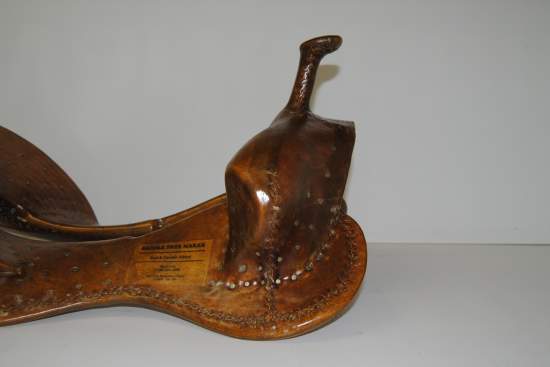
I shipped this tree yesterday. It is going to a saddle maker here in Alberta who will build the saddle for a woman who had her right leg amputated above the knee. This woman still rides and is comfortable in her original saddle in the arena. But when she rides outside she isn't as secure in the saddle as she would like to be if her horse jumps or spooks at all.
This week in the shop
Posted by RodandDenise on September 16, 2011
We are no longer building saddle trees, but we have two videos about how Western saddles fit horses available on our westernsaddlefit.com website.
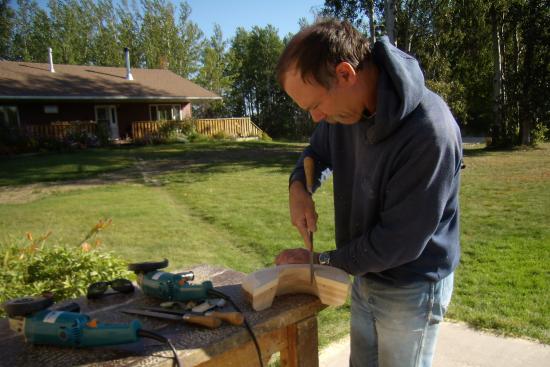
Rod putting the finishing touches on a wood post Bowman fork.
Still no frost! The grass is green and the flowers are blooming and it is still warm enough to be working outside - albeit with a jacket on. In the summer Rod does as much wood working outside as possible for a couple of reasons. One is that he just prefers to be outside, and the hotter the better! The other is the dust. Despite our great dust collection system, he still needs to wear a dust mask for all the carving he does with the grinder in the "dirty room". Outside, the wind blows it away and it is much nicer, not to mention healthier.
How we use the Dennis Lane Equine Back Profiling System numbers
Posted by RodandDenise on September 13, 2011
We are no longer building saddle trees, but we have two videos about how Western saddles fit horses available on our westernsaddlefit.com website.
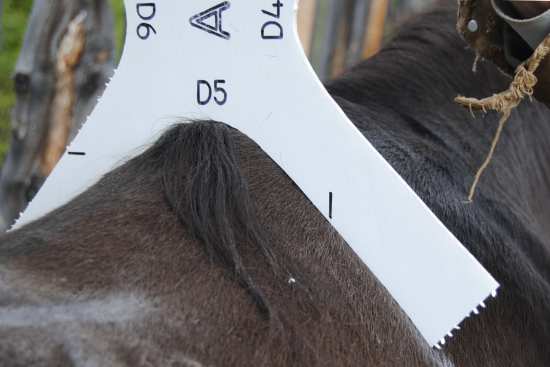
We occasionally get people asking us how we use the Dennis Lane card system in building our trees, so I figured I would try to explain in a bit more detail than I have on our main website. We put up a section on how the cards are used on a horse to determine the shape of the horse so if you are unfamiliar with the system, there are lots of pictures there that explain it here on our site or you can go to Dennis's site and see his instructions.
What we don’t do
So when someone tells us their results, what do we do? Do we make bars the inverse shape of the cards? Do we have a whole jig system so we set it up to look just like that horse’s back and fit the tree to that as we build it? Do we have a bar pattern for every possible combination and permutation of bar specs? NO, NO, NO!!! None of the above!!
Duplicating trees Part 2- making the replacement
Posted by RodandDenise on September 9, 2011
We are no longer building saddle trees, but we have two videos about how Western saddles fit horses available on our westernsaddlefit.com website.
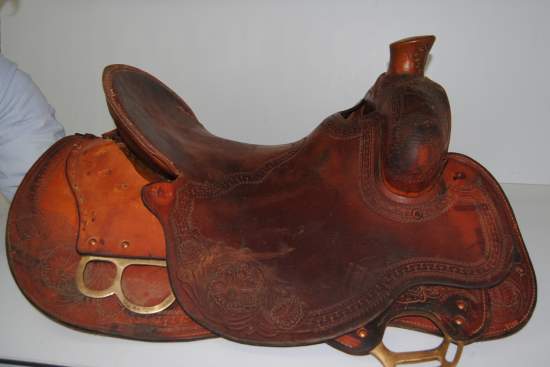 |
| This is a different tree than the last post, finished and with a lot of the leather in place. It should go back together pretty well. |
Figuring out the specs
Once we have all the measurements taken, Denise goes to our charts and tries to figure out how we can make something come out the same but built with our angles. If the cantle angle looks different than what we make, if the cantle cuts on the bar are a lot different, if the cantle corners come farther down or up the bar than ours do, how do we make the seat length right so the seat still fits, but get the thigh length right so the seat jockey fits between fork and cantle properly? Can we make the cantle height at the back measure the same so the cantle back still fits on yet make the face work for the seat when the angles are all different? And if we are changing the fitting specs from a 5” wide hand hole to a 4” wide hand hole (which we have done) how can we do that and still have the skirts and fork cover go back on easily? It is often the more poorly made trees that are the hardest to get right.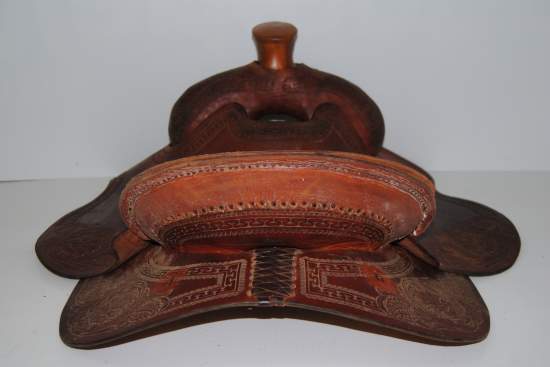
Duplicating trees Part 1 - taking them apart
Posted by RodandDenise on September 8, 2011
We are no longer building saddle trees, but we have two videos about how Western saddles fit horses available on our westernsaddlefit.com website.
We have had a run on duplicate trees the last few months. Maybe the economy is such that people are willing to spend the $ to replace a tree in a saddle rather than buy a new one. Whatever the reason, we have had “bits of saddles in a box” in our back room constantly since early in the year.
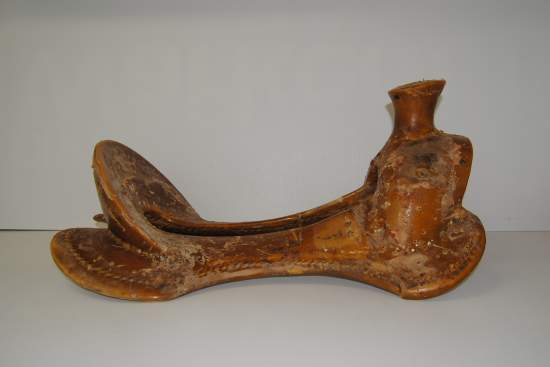 |
| It may look OK, but it sure squeaked and bent in the middle. |
Why do people want trees duplicated?
Most commonly, it is because the tree broke, but right up there in numbers are people replacing trees that don’t fit well. Some have been from old saddles that still have good leather but the tree doesn’t fit today’s “normal”, and some have been from new saddles that just aren’t working for the horses they are riding.
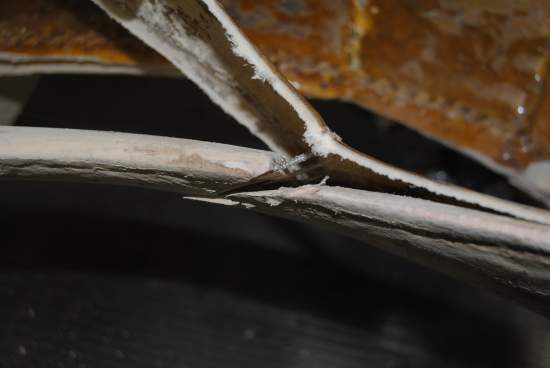 |
|
Taking off the rawhide, we found both bars broken along the angle of the nails |
This Week in the Shop
Posted by RodandDenise on September 3, 2011
We are no longer building saddle trees, but we have two videos about how Western saddles fit horses available on our westernsaddlefit.com website.
Two Wades, Two Modified Associations
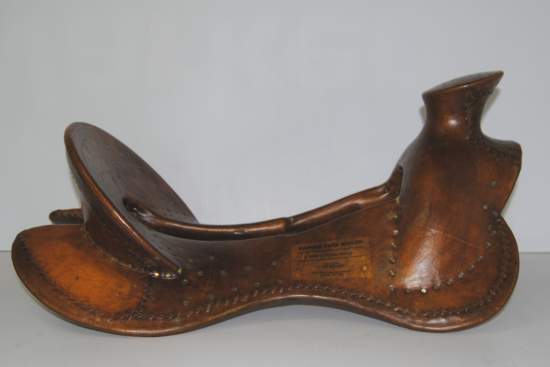
What keeps treemakers amused
Posted by RodandDenise on September 3, 2011
We are no longer building saddle trees, but we have two videos about how Western saddles fit horses available on our westernsaddlefit.com website.
Double Flips!
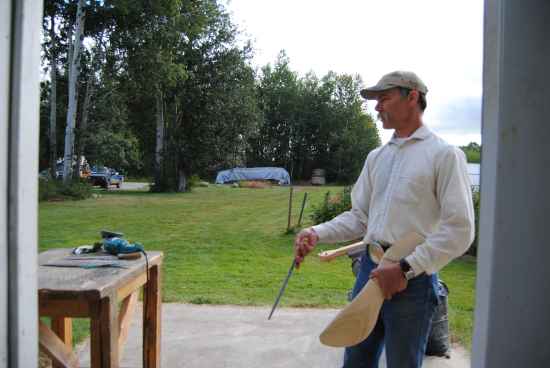
Effect of weight on the horse's back - Part 2
Posted by RodandDenise on August 30, 2011
We are no longer building saddle trees, but we have two videos about how Western saddles fit horses available on our westernsaddlefit.com website.
Last post I told you about a study on how weight on a horse's back affected them, and how the study was performed.
So what did they find…
in the three areas the researchers were checking:
1.) how flexed (rounded) or extended (hollowed) the back was
2.) how the total range of motion was affected
3.) how the leg positions changed?
Lunging girth
First, there was no difference at all with a lunging girth, which tells us that pressure around the horse doesn’t affect his back movement. (There is another study that shows how tight the girth/cinch is does affect respiratory performance. Hint - too tight slows them down!)
Saddle only
Second, there was no difference with just a saddle at a walk and trot, and only a slight extending (hollowing) effect at a canter.
Saddle with weight
Third, with weight, the back was constantly more extended (hollowed) in all three gaits, but the range of motion was the same as without weight. In other words, the back moved up and down the same amount, but it was more hollow at the most hollow and not as flexed at the most flexed. Overall, under weight, a horse’s back sags. They do not, in and by themselves, round their backs to carry weight.
Effect of weight on the horse's back - Part 1
Posted by RodandDenise on August 24, 2011
We are no longer building saddle trees, but we have two videos about how Western saddles fit horses available on our westernsaddlefit.com website.
There are many people who teach that the horse rounds his back under saddle so you should build a tree so that it bridges slightly, leaving room for that rounding. Some even go to the point of poking the horse in the belly to get him to lift his back when they evaluate trees. This is a highly promoted technique by at least one very influential individual with peer reviewed papers to her name. There are others who say that you should fit the horse as he stands because they don’t round up under saddle, or at least not in that way, and you don’t want a saddle bridging. And intuitively, if you put weight in the center of a flexible structure only supported on two ends, it will sag in the middle. So if you ask tree makers “What would you prefer if you had to make the choice – too little rock or too much rock?” you will get both answers. A study that evaluates the changes in shape in the horse’s back under tack and weight compared to a bare horse is really valuable to tree and saddle makers.
Who did it and why?
In 2004, there was a paper published in the Equine Vet Journal written by P. de Cocq, P.R. van Weeren and W. Back from the Faculty of Veterinary Medicine, Utrecht University in the Netherlands. This university, and especially some of these authors, have published a lot of peer reviewed papers on equine biomechanics and factors that affect them. This one was titled “Effects of girth, saddle and weight on movements of the horse”. In it, they state that “the effects of saddle and weight on the back movements of the horse have never been studied…” We’ve been riding horses for thousands of years, and only within the last 10 – 20 has the technology been available to answer some questions we as saddle and tree makers argue about - probably the same questions the cavalry officers of Alexander the Great were arguing about.
